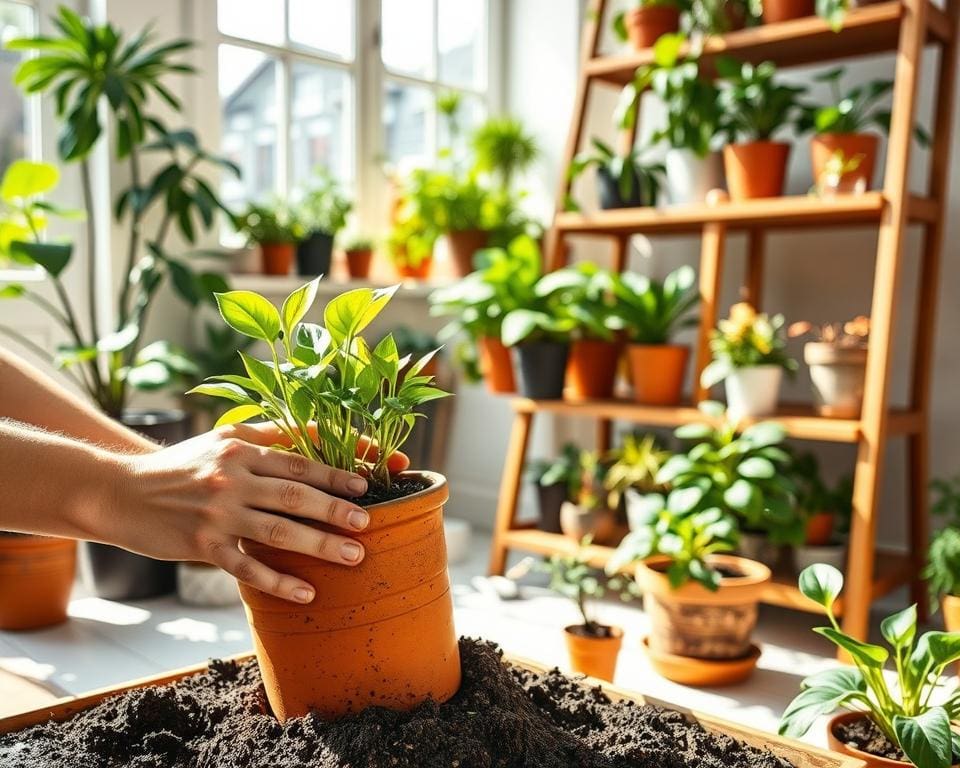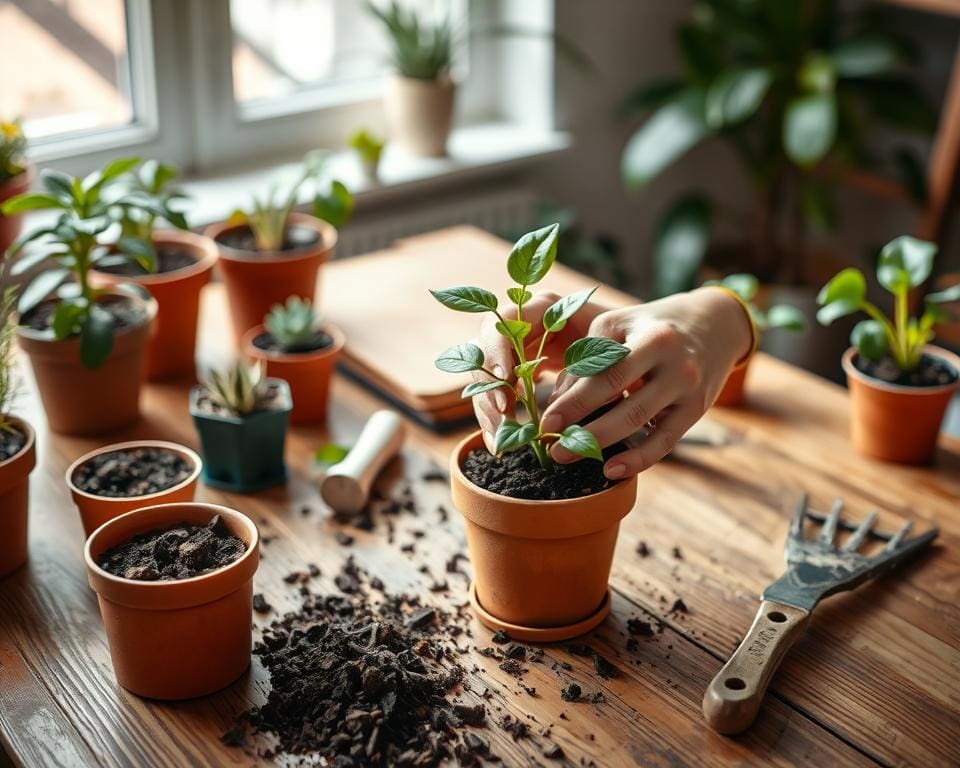Potted houseplants bring vibrancy and life into our indoor spaces, transforming the atmosphere in ways we often underestimate. Understanding how to pot house plants effectively is fundamental for anyone passionate about indoor gardening. Proper potting techniques are crucial for the survival and flourishing of plants in confined environments, ensuring they thrive while enhancing your home’s aesthetic appeal. This guide will walk you through the essential steps for potting indoors plants, from selecting the right materials to recognising specific plant needs, ultimately nurturing a deeper connection with nature.
Understanding the Importance of Potting Indoors Plants
Potting indoors plants effectively lays the foundation for vibrant and thriving greenery within your home. Proper potting techniques contribute significantly to a plant’s health, encouraging growth while ensuring an environment in which they can flourish. Adequate drainage, airflow, and nutrient availability are essential for indoor gardening, setting the stage for successful house plant care.
Benefits of Proper Potting Techniques
Strongly rooted plants tend to exhibit greater resilience against pests and diseases. The advantages of implementing proper potting techniques include:
- Enhanced Drainage: Ensures excess water can escape, preventing root rot.
- Improved Airflow: Facilitates healthy root systems, leading to robust growth.
- Optimal Nutrient Access: Maximises nutrient absorption, vital for development.
- Reduced Risk of Pests: Healthier plants are less appealing to harmful insects.
Choosing the Right Moment to Pot
Timing plays a critical role in effective potting. By selecting an appropriate moment, such as during the plant’s active growing season or in accordance with seasonal changes, you can optimise their health and vitality. Key considerations for choosing the right moment include:
- Observe growth patterns to identify ideal replanting times.
- Factor in environmental conditions for successful transitions.
- Assess the plant’s current pot size and root development status.

How To Pot House Plants for Optimal Growth
Potting house plants successfully requires the right tools and materials to create a thriving environment. Understanding how to pot house plants begins with gathering essential items that ensure your indoor gardening experience is enjoyable and fruitful. The selection of an appropriate potting mix plays a pivotal role in the health of your plants, catering to their specific needs and promoting optimal growth.
Essential Tools and Materials Needed
To embark on your potting indoors plants journey, gather the following tools and materials:
- Quality pots suited for your plants
- Gardening gloves to protect your hands
- A trowel for easy digging and placement
- Drainage materials such as pebbles or broken pottery to allow excess water to escape
- Watering can or spray bottle for moisture regulation
Choosing the Right Potting Mix
Selecting the right potting mix is crucial for maintaining healthy plants. Opt for a mix designed specifically for indoor gardening, ensuring it contains ingredients that encourage drainage and aeration. Common components include:
- Peat moss for moisture retention
- Perlite or vermiculite to enhance drainage
- Compost for added nutrients
A high-quality potting mix not only allows roots to breathe but also facilitates nutrient uptake, essential for the growth and vitality of house plants. Investing time in understanding these elements will lead to successful potting and flourishing greenery in your home.
Picking the Perfect Indoor Plant Pots
Selecting the right indoor plant pots can make a significant difference in the health and growth of your beloved houseplants. Both the material and size of the pot play crucial roles in ensuring that potting indoors plants thrive. Consideration of these factors not only affects aesthetics but also influences the plant’s overall well-being.
Material Options for Plant Pots
When choosing pots, various materials offer different advantages and drawbacks. Here are some popular options:
- Terracotta: This traditional option allows for good air circulation and moisture control, making it ideal for plants that prefer drier conditions.
- Ceramic: Often glazed for a beautiful finish, ceramic pots retain moisture well. Choose a type with drainage holes to avoid waterlogged soil.
- Plastic: Lightweight and inexpensive, plastic pots are easy to handle. They retain moisture longer, which can be beneficial for beginners.
- Biodegradable Pots: Made from organic materials, these pots are eco-friendly and decompose over time, perfect for those seeking sustainable gardening options.
Size Matters: Selecting the Right Size Pot
Choosing the right size pot is essential for providing adequate root space for your plants. A pot that is too small can restrict growth, while an excessively large pot may lead to overwatering issues. Here are several tips for selecting the appropriate size:
- For small plants, select a pot that is 1-2 inches larger in diameter than the current root ball.
- Larger plants typically require pots that are at least 4-6 inches wider to accommodate their root systems effectively.
- Consider the plant’s growth rate; fast-growing plants may need larger pots sooner than expected.
Steps for Successfully Planting House Plants
Planting house plants involves careful steps to ensure their healthy growth and longevity. The first stage is to prepare both the plant and pot effectively. A gentle approach during this phase makes a significant difference in the well-being of your green companions. Following this, the right positioning techniques can dramatically enhance their access to light, which is crucial for photosynthesis and overall plant health.
Preparing the Plant and Pot
Begin by carefully removing the plant from its previous container. Inspect the roots for any signs of damage or rot, as this will influence the plant’s health going forward. If necessary, trim off any unhealthy areas to promote fresh growth. Next, prepare the pot by ensuring it has adequate drainage holes. If your chosen pot lacks them, consider adding stones or broken pot pieces at the bottom to prevent waterlogging. Following that, fill the pot with a suitable potting mix that retains moisture while promoting airflow to the roots, essential for effective house plant care.
Plant Positioning Techniques
Once the plant is nestled into its new home, positioning it correctly is vital. Place the pot in a location where it can receive the right amount of natural light without being exposed to harsh, direct sunlight for prolonged periods. Rotate your plants occasionally to ensure all sides receive equal light exposure, encouraging balanced growth. With proper house plant care, your efforts in planting house plants will lead to flourishing greenery, enhancing the beauty of your indoors.
Container Gardening: Enhancing Your Indoor Space
Container gardening offers an excellent opportunity to create a lush, vibrant atmosphere within your home. By selecting the right combinations of potted houseplants, you can foster a thriving indoor environment that serves both aesthetic and functional purposes.
Choosing Ideal Plant Combinations
When embarking on your container gardening journey, consider pairing plants that complement each other in terms of growth habits and care requirements. Some ideal combinations might include:
- Ferns with peace lilies for a lush, leafy effect.
- Succulents with cacti for a stunning low-maintenance arrangement.
- Herbs, such as basil and mint, for both culinary use and fragrance.
These combinations not only create visual appeal but also contribute to a more balanced indoor gardening experience by ensuring that each plant thrives in its shared environment.
Layering and Aesthetic Arrangements
Layering plants within your containers can significantly enhance the depth of your gardening display. Taller plants can be positioned at the back, with medium-height varieties in the centre, and trailing species hanging over the edges. This arrangement encourages a dynamic look that captures the eye. Consider these tips for aesthetic arrangements:
- Mix textures and colours to create an engaging visual experience.
- Ensure that the texture of the pots aligns with the overall theme of your space.
- Regularly rotate pots to allow all plants to receive ample light.
By thoughtfully combining and layering your potted houseplants, you can cultivate a stunning indoor gardening oasis that elevates your living space.
House Plant Care After Potting
After potting, the journey of your house plant does not end. Proper care becomes vital for helping it acclimatise to its new environment. Understanding effective house plant care practices, particularly regarding watering and fertilising, allows you to foster robust plant growth and vitality.
Watering Tips for Newly Potted Plants
Watering plays a crucial role immediately after potting. New potting mixes often require different moisture levels compared to their previous environment. Adjust your technique based on the type of plant. Here are some essential watering tips:
- Check the moisture level of the potting mix before watering; allow the top few centimetres to dry out for most plants.
- Avoid overwatering, which can lead to root rot; ensure that excess water drains freely from the pot.
- Use room temperature water and apply it thoroughly to saturate the soil and promote root establishment.
Fertilising and Additional Nutrient Needs
After providing adequate watering, consider your plant’s nutrient requirements. Newly potted plants can benefit from appropriate fertilising and an understanding of their nutritional needs is vital to support growth. Follow these guidelines:
- Wait about four to six weeks before fertilising, allowing the plant time to settle in.
- Select a balanced, water-soluble fertiliser to provide essential nutrients for your plants.
- Monitor the plant’s health and adjust fertilising frequencies based on its growth phase and seasonal changes.
When and How to Repotting Plants
Understanding when to repotting plants is crucial for their growth and longevity. Signs that indicate a plant is in need of repotting include roots that have begun to thrust out of the drainage holes, stunted growth, or noticeable degradation of the existing soil. These signs suggest that your indoor plants are outgrowing their current pots, and it’s essential to provide them with more space and fresh nutrients.
The process of repotting plants is relatively straightforward but requires some attention to detail. Start by selecting a container that is one size larger than the original pot, ensuring it has proper drainage. A fresh potting mix is vital, as it revitalises the soil, providing the necessary nutrients for continued growth. When repotting, carefully remove the plant from its pot, loosen any tightly bound roots, and place it in the new pot with the prepared mix.
Mastering the timing and techniques for repotting plants will significantly enhance your indoor gardening experience. By understanding how to pot house plants effectively, you foster an environment that encourages healthy growth and transforms your living space into a vibrant oasis. Properly timed repotting not only ensures the wellbeing of your plants but also creates a thriving indoor atmosphere.









